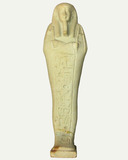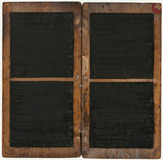The Works of Geoffrey Chaucer
The masterpiece by William Morris, 1896The volume The Works of Geoffrey Chaucer from the year 1896 is the main work printed by Kelmscott Press. William Morris saw the English poet and writer Chaucer (circa 1340-1400) as a role model for his own literary aspirations.
Title page of the Roman index
Proscribed under the Inquisition, 1711In the period from 1559 to 1948, the Roman Catholic Church published the Index librorum prohibitorum on an irregular basis. The index served as a directory of books which were not to be read by Catholics, under threat of excommunication.
Toy theatre
Theatre and opera in miniature, c. 1890Toy theatre, miniature theatres made of paper, were a popular form of entertainment in the 19th century. The bourgeoisie had discovered theatre and opera culture and wanted to transfer that enthusiasm to the living room. Scenery, figures and props were cut from coloured Èpinal prints and adhered to cardboard to create a set.
Type Samples by Peter Hammer, 1808
A phantom publisher as authorThe citing of Peter Hammer as the author of type samples is unusual for two reasons. The name was known as that of a fictitious publisher, not that of a writer.
Umbra vitae
Expressionist book design by Ernst Ludwig Kirchner, 1924Expressionist poet Georg Heym died at a young age (1887-1912); his works appeared shortly after his death and inspired Expressionist painter Ernst Ludwig Kirchner.
Ushabti
Burial objects in Ancient EgyptUshabti is a term used to describe Ancient Egyptian burial objects which, according to Egyptian belief systems, worked on behalf of the deceased in the underworld and represented them before a court of the dead. The figurines were stored in or near the deceased’s grave.
War of the Worlds
A radio drama causes a sensation, 1938On 30 October 1938, the evening before Halloween, the population of America’s East Coast was confronted with the unimaginable: the CBS radio station broadcast a report of a violent alien invasion that had started in New Jersey and had now reached New York in spite of desperate measures by the human inhabitants to defend against the attack.
Was hört unser Kind durchs Radio? (What does our child hear through the radio?)
A book all about radio to be read out loud, 1925Published by the Jaser Kunstverlag of Nuremberg in 1925, Was hört unser Kind durchs Radio? (What does our child hear though the radio?) - conceived as a pedagogical picture book by its authors Clara Fritzsche (text) and Johann Peter Werth (illustrations) - gave children an introduction to the variety of programmes on the new radio medium by means of short rhyming verses. The title, which is clearly aimed at parents, indicates that the book was to be read aloud so as to stimulate the interest of young listeners.
Wax tablet with interest amounts on it
Early medium for notes, bills and lettersThese wooden memorandum books, coated on both sides with coloured beeswax, contain written entries detailing interest yields on monastic land, including vineyard properties, from 1360 until the middle of the 15th century. Wax tablets were an important written medium beginning in the Ancient Greek and Roman periods lasting until the Middle Ages.
Zedler’s Encyclopaedia
The knowledge of the times in around 300,000 articles, 1732-1750The most comprehensive and important German-speaking encyclopaedia of the 18th century was published over the course of more than 20 years by the Leipzig-based publisher Johann Heinrich Zedler. From 1732 onwards, he released 64 full volumes and 4 supplemental editions of the Großes vollständiges Universallexikon aller Wissenschaften und Künste, known today simply as “der Zedler”.











